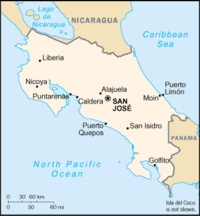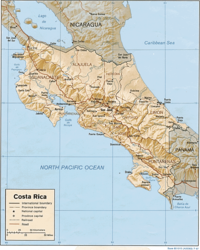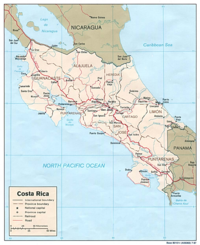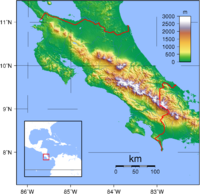- Geography of Costa Rica
-
Costa Rica is located on the Central American Isthmus, surrounding the point 10° north of the equator and 84° west of the prime meridian. It borders both the Caribbean Sea (to the east) and the North Pacific Ocean (to the west), with a total of 1,228 km of coastline (212 km on the Caribbean coast and 1,016 km on the Pacific).
Costa Rica shares a border with Nicaragua to the north (309 km long border) and with Panama to the south (330 km long border). The area of Costa Rica is 51,100 km² of which 50,660 km² is land and 440 km² is water, making it slightly smaller than the U.S. state of West Virginia.
Contents
Physical geography
The nation's terrain is coastal plain separated by rugged mountains, the Cordillera Central and the Cordillera de Talamanca, which form the spine of the country and separate the Pacific and Caribbean watersheds. Costa Rica claims an exclusive economic zone of 200 nautical miles (370.4 km; 230.2 mi) and a territorial sea of 12 nautical miles (22.2 km; 13.8 mi).
The spine of the country produces many major river systems. Rivers draining into the Caribbean include:
- Colorado River (Rio Colorado)
- Pacuare River (Rio Pacuare)
- Reventazón River (Rio Parismina)
- Reventazón River (Rio Reventazon)
- Sixaola River (Rio Sixaola)
Rivers draining into the Lake Nicaragua or the San Juan River (Rio San Juan), whose waters eventually drains into the Caribbean, include:
- Sapoá River (Rio Sapoá)
- Frío River (Rio Frío)
- San Carlos River (Rio San Carlos)
- Sarapiquí River (Rio Sarapiquí)
Rivers draining into the Pacific Ocean include:
- Abangares River (Rio Abangares)
- Guacimal River (Rio Guacimal)
- Sierpe River (Rio Sierpe)
- Tempisque River (Rio Tempisque)
- Térraba River (Rio Terraba)
In the eastern half of the country, the San Juan River forms the northern border with Nicaragua.
Mountain ranges
Ganet peak
Cordillera de Tilarán
The Tilaran Range is part of the Continental Divide east of Lake Arenal and the nearby active volcano Arenal, and running into the Cordillera Central range further east. It is located in the Abangares district of the province of Guanacaste.
At the edge of the range is the Monteverde cloud forest preserve, a major ecotourism destination.
Cordillera Central
The Central Range continues the Continental Divide east of Cordillera de Tilarán. It has four large volcanoes: Poás, Barva, Irazú and Turrialba. The highest peak is Irazú at 3,432 m.
Cordillera de Guanacaste
The Guanacaste Range is in northern Costa Rica near the border with Nicaragua. The range forms part of the southern region of the Continental Divide, the highest peak being the extinct stratovolcano Miravalles at 2,028 m. Peaks include:
- Miravalles Volcano (2,028 m)
- Orosí Volcano (1,659 m)
- Rincón de la Vieja Volcano (1,916 m)
Cordillera de Talamanca
Much of the Talamanca Range is included in the La Amistad International Park, which is shared between Costa Rica and Panama. The country's highest peaks lie in this mountain range: the Cerro Chirripó and the Cerro Kamuk. Much of the region is covered by the forest.
Cerros de Escazú
The Cerros de Escazú borders the Central Valley to the south and is considered the northernmost portion of the Cordillera de Talamanca.
Volcanoes
- Four volcanoes (two of them active) rise near San Jose, in the center of the country; one of the volcanoes, Irazu Volcano, erupted destructively in 1963-1965.
Climate
The country has a tropical and subtropical climate and is part of the Neotropic ecozone. It is part of many ecoregions, including Costa Rican seasonal moist forests, Bocas del Toro-San Bastimentos Island-San Blas mangroves, Mosquitia-Nicaraguan Caribbean Coast mangroves, Southern Dry Pacific Coast mangroves, Central American dry forests, and Talamancan montane forests. An inlet from the Pacific the Gulf of Nicoya contains several small islands, the largest of these being Chira Island with a population of around four thousand.
Costa Rica's dry season in most places is from December to April, while the rainy season is from May to November. On the Caribbean coast, however, December is by far the wettest month. The highlands areas are always cooler. The lowest elevation levels in the country are on the western and eastern coasts, at sea level. The highest point is Cerro Chirripó, a volcanic mountain with an elevation of 3,810 m (12,500 ft) (part of Chirripó National Park). On a clear day, it is possible to see both the Caribbean and the Pacific from the peak.
Ecology
Like all Central American countries, Costa Rica is considered part of a biodiversity hotspot. According to the INBio, about 4.5% of the world's biodiversity can be found in Costa Rica.
Costa Rica is home to about 12,119 species of plants, of which 950 are endemic.[1] There are 117 native trees and more than 1,400 types of orchids, a third of them can be found in the Monteverde Cloud Forest Reserve.[2] Almost a half of the country's land is covered by forests, though only 3.5% is covered by primary forests.[1] Deforestation is a devastating process, with more than 8,100 ha of forest being lost annually. The main reason for such high deforestation levels is to make plains for cattle ranching.
Wildlife diversity is very high; there are 441 species of amphibians and reptiles, 838 species of birds, 232 species of mammals and 181 species of fresh water fish. Costa Rica has high levels of endemism; 81 species of amphibians and reptiles, 17 species of birds and 7 species of mammals are endemic to the country. However, many species are endangered. According to the World Conservation Monitoring Centre, 209 species of birds, mammals, reptiles, amphibians and plants are endangered.[3] Some of the country's most endangered species are the Harpy eagle, the Giant anteater, the Golden toad and the Jaguar. IUCN reports the Golden toad as extinct.[4]
Protected areas
The country is noted for its national park system, administered by SINAC (Sistema Nacional de Areas de Conservacion, or "National System of Conservation Areas"). This agency oversees the 26 national park, and more than 160 protected areas in Costa Rica. The other types of protected areas in Costa Rica are National Wildlife Refuges, Biological Reserves, Protection Zones, and Absolute Nature Reserves. Together the protected areas comprise over one-fourth of Costa Rican territory. 9.3% of the country is protected under IUCN categories I-V.
Tortuguero National Park
The creation of the Tortuguero National Park in 1970 gave much needed protection to one of the region's most important and unique natural resources: a 22 km stretch of shoreline that serves as the principal nesting site for sea turtles.
International law
Costa Rica is party to many environmental treaties, including the Convention on Biological Diversity, the Convention on Environmental Modification, the United Nations Framework Convention on Climate Change, the Montreal Protocol, the Ramsar Convention, the International Convention for the Regulation of Whaling, the Desertification Convention, the Endangered Species Convention, the Basel Convention, the Convention on the Law of the Sea, the Convention on Marine Dumping, the Comprehensive Test Ban Treaty. It has signed but not ratified the Convention on Marine Life Conservation and the Kyoto Protocol.
Central America gained independence from Spain on September 15, 1820.
Geography
Area
- Total: 51,100 km²
- Land: 50,660 km²
- Water: 440 km²
Land boundaries
Coastline
- 1,290 km
Maritime claims
- Territorial sea: 12 nmi (22.2 km; 13.8 mi)
- Exclusive Economic Zone: 200 nmi (370.4 km; 230.2 mi)
- Continental shelf: 200 nmi (370.4 km; 230.2 mi)
Climate
- Tropical and subtropical; dry season (December to April); rainy season (May to November); cooler in highlands
Terrain
- Coastal plains separated by rugged mountains including over 100 volcanic cones, of which several are major volcanoes.
Elevation extremes
- Lowest point: Pacific Ocean 0 m
- Highest point: Cerro Chirripo 3,820 m
Natural resources
- Hydropower from Lake Arenal, the largest lake in Costa Rica.
Land use
- Arable land: 4.4%
- Permanent crops: 5.87%
- Other: 89.73%
Irrigated land
- 1,080 km²
Total renewable water resources
- 112.4 km³
Freshwater withdrawal
- Total: 2.68 km³/year (29%/17%/54%)
- Per capita: 620 m³/year
Natural hazards
- Occasional earthquakes, hurricanes along Atlantic coast; frequent flooding of lowlands at onset of rainy season and landslides; active volcanoes (See Climate of Costa Rica).
Environment
- Deforestation, largely a result of the clearing of land for cattle ranching; soil erosion; coastal marine pollution; fisheries protection; solid waste management; air pollution
See also
- Costa Rica
- Climate of Costa Rica
- List of earthquakes in Costa Rica
- List of Faults in Costa Rica
References
- ^ a b [1] Retrieved on August 4, 2009
- ^ http://www.monteverdeinfo.com/monteverde/orchid-garden/photo.htm
- ^ http://www.unep-wcmc.org/
- ^ http://www.iucnredlist.org/apps/redlist/details/3172/0/full IUCN Red List's article about the Golden toad
Mountains of Costa Rica Agua Gata · Anunciación · Arenal · Azufrado · Barva · Cerro Barrera · Bijagua · Cerro Bola · Braum · Cerro Cacao · Cacho Negro · Caldera de Miravalles · Cañas Dulces · Cerro Cedral · Cerro Buenos Aires · Cerro de la Muerte · Cerro de Las Vueltas · Cerros de Escazú · Chachaguita · Chato · Chirripó · Chompipe · Coco Mountain · Cocorí Mountain · Concepción Mountain · Congo Mountain · Coronel Mountain · Coto Pelón · Cotón · Crestones (Costa Rica) · Dikar · Doussaints · Duan Mountains · Durika · Echandi · El Hacha · El Jaboncillo · Espiritu Santo Mountain · Fortuna Mountain · Gorgona Mountain · Iglesias · Irazú · Juan Murillo Mountain · Kámuk · Laguna Bosque Alegre · Laguna Poco Sol · Laguna Rio IV · Loma Barrantes · Loma Morera · Lomas · Los Chiles · Mano de Tigre · Miravalles · Monte de la Cruz · Montezuma Mountain · Morazán Mountain · Negro · Olla de Carne · Orosi · Palmira Mountain · Pasquí · Pata de Gallo · Pelado y Delicias · Pelón · Perdidos · Pico Alto (Costa Rica) · Pico Blanco · Piedra de Fuego · Platanar · Poás · Porvenir Mountain · Quemados · Quezada Mountain · Rabo de Mico · Rincón (Costa Rica) · Rincón de la Vieja · San Miguel Mountain · San Roque Mountain · San Vicente Mountain · Santa Maria Mountain · Siete · Sinsal · Tenorio · Tilarán · Tortuguero Mountain · Truncado · Turrialba · Urán · Valle Hermoso Mountain · Ventisqueros · Viejo · Von Francius · Von Seebach · Vuelta Kopper · Weyl Mountain
Sovereign states Dependencies and
other territories- Anguilla
- Aruba
- Bermuda
- Bonaire
- British Virgin Islands
- Cayman Islands
- Curaçao
- Greenland
- Guadeloupe
- Martinique
- Montserrat
- Navassa Island
- Puerto Rico
- Saint Barthélemy
- Saint Martin
- Saint Pierre and Miquelon
- Saba
- Sint Eustatius
- Sint Maarten
- Turks and Caicos Islands
- United States Virgin Islands
Categories:
Wikimedia Foundation. 2010.





